2 nights in – The Modernists Thessaloniki
Located on Aegean Sea, Thessaloniki is the second largest city in Greece. This delightful city has an impressive multiethnic heritage, influenced by the different civilizations that have left their mark, including the Romans, Venetians, and Ottoman Turks. It has some of the best Byzantine churches, ancient ruins and a world-class archaeological museum.
We drove to this city from Ioannina (260 km) which took us about 3 hours, passing through a dozen well-maintained tunnels. After checking into our hotel, we returned our rental car and took a stroll along the gorgeous Aegean sea down to the white tower.
- The White Tower
- Galerius Palace Complex – Arch of Galerius
- Galerius Palace Complex – Rotunda of Galerius (St George Church)
- Galerius Palace Complex – Other Ruins
- Church of Saint Sophia
- The Church of Agios Dimitrios
- Ano Poli (Upper Town)
- Citadel (or Heptapyrgion)
- Trigonion Tower (Alysos Tower)
- Church of St Paul
- Roman Forum (or Ancient Agora)
- Church of Panagia Halkeon
- Church of Holy Apostles
- Walking the streets of Thessaloniki
The White Tower – This is one of the most recognizable landmark of Thessaloniki and as mentioned, a wonderful walk along the waterfront took us to this place. Built by Ottoman Turks around 1530, it was used successively as a fortress, garrison and a prison. The current name of The White Tower came to be in 1890, when the tower was whitewashed by a convict in exchange for his freedom. After the incorporation of Thessaloniki into Greece in 1912, the tower became the symbol of the city and although the tower is now a buff colour, it has retained the name White Tower.


There is an entrance fee to go up the tower but as it was the last weekend of September – all the attractions were free. There are about 100 steps to the top. You will pass by about 6 floors before you reach the top. From the top, visitors can enjoy a 360-degree view of Thessaloniki.



Galerius Palace Complex buildings – The Palace of Galerius was built between 3rd – 4th century AD by the Roman Emperor Galerius who ruled the eastern part of the Roman Empire from 293-311 AD. He gained power after he defeated the Persians in 299AD, a victory celebrated by the Triumphal Arch of Galarius. The palace complex was built on a straight axis from North to South, and included buildings like the Rotunda, the Triumphant Arch, the Palace, the Octagon and the Hippodrome. The remains of all the building are visible as you walk around the city in a giant sunken open-air museum mostly on Navarino Square. The only buildings that remain in somewhat well preserved state are the Rotunda, and the Triumphant Arch.
Galerius Palace Complex, Arch of Galerius – Also known as Kamara and built in AD 297, it was the ancient town’s main entrance and part of Galerius Palace Complex. Of the original structure, three piers of the west side remain.

The intricate reliefs on two of the surviving piers, depict battle scenes from Emperor Galerius’ Persian, Mesopotamian, and Armenian campaigns of the third and fourth centuries. These ornately carved reliefs are among the finest of their kind.


Galerius Palace Complex, Rotunda of Galerius – Part of the Galerius Palace Complex, it is one of the oldest monuments in Thessaloniki. It has been in existence for 16 centuries, as a pagan monument, Christian church and Muslim house of worship. The minaret next to the Rotunda is a relic of Islamic era under Ottoman rule. After the liberation from Turks in 1912, the Rotunda was transformed into the church of St George. It is now one of the 15 Paleo Christian and Byzantine Monuments of Thessaloniki that were included in the UNESCO World Heritage List in 1988.
Some scholars believe that it was built as a mausoleum for its founder, while others have suggested that it was a temple dedicated to Zeus which may be correct because Emperor Galerius was not buried here.


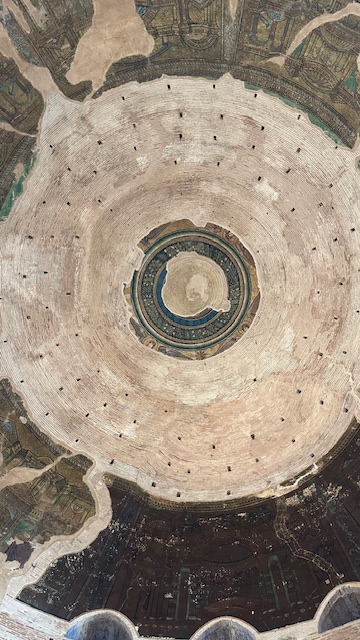
Galerius Palace Complex – Other Ruins – Most of the other ruins of the Galerius Palace complex are strewn around the city centre, at Navarino square. They are enclosed within a low walled fence and can be seen as you walk around this area.



Church of Saint Sophia – This church was built on the ruins of an early Christian 5-asile basilica in the middle of 8th century. Its structure was based on the Hagia Sophia in Constantinople (present day Istanbul). It was the Cathedral Church of Thessaloniki until 1524 when it was converted into a mosque. It was reconverted to a church upon the liberation of Thessaloniki in 1912. It is one of the oldest churches in the city still standing today. Because of its outstanding Byzantine art and architecture, in addition to its importance in early Christianity, it was listed as a UNESCO World Heritage Site in 1988.
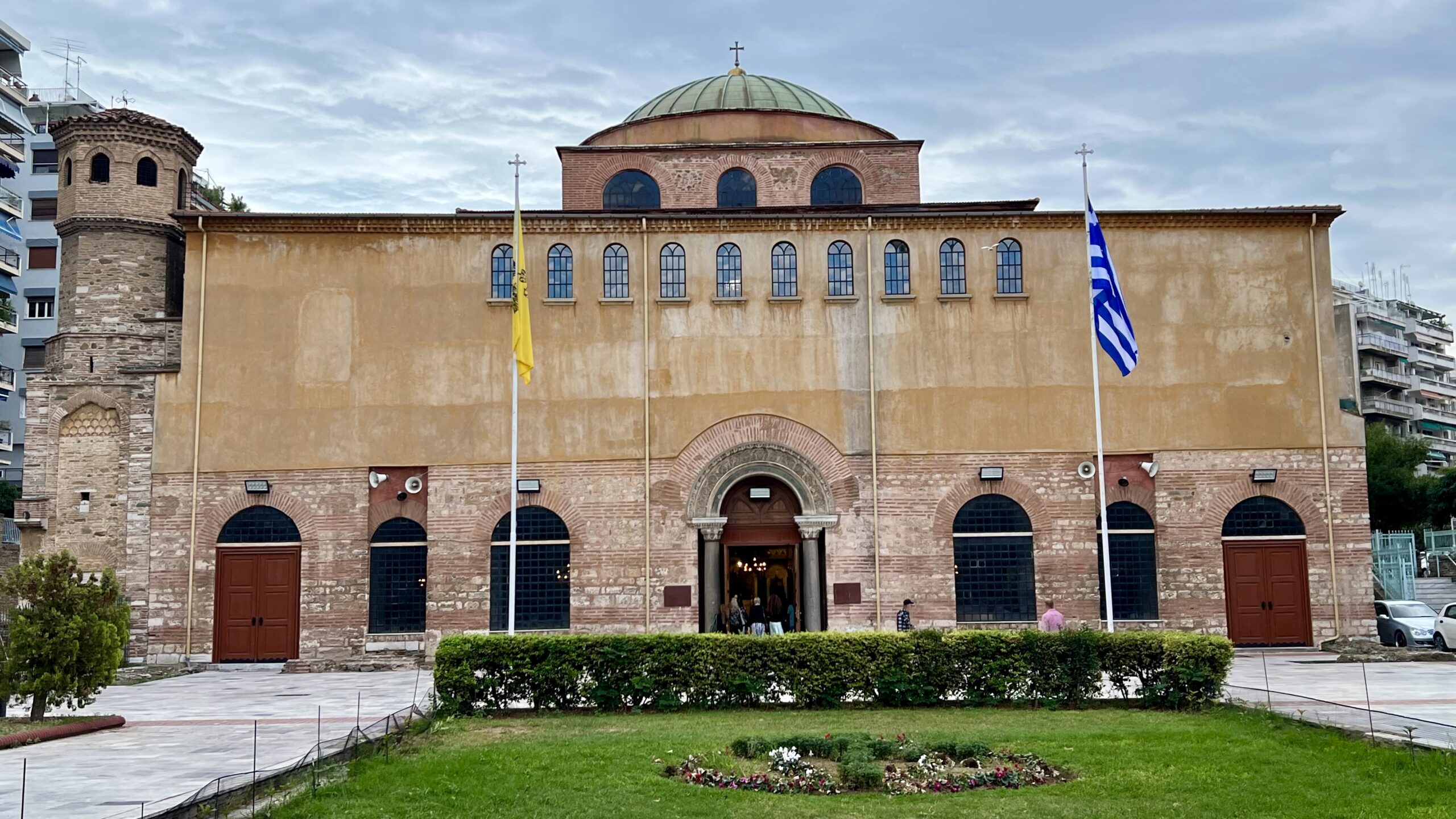


The Church of Agios Dimitrios – This is the city’s largest church (UNESCO World Heritage Site) and the main sanctuary is dedicated to its patron saint, Agios Dimitrios, a Roman soldier who was executed at this site in 306 AD. At that time it was a Roman bathhouse and the murder was ordered by Emperor Galerius who was ruthless in his persecution of Christians. This church was built in the 4th century. It was restored after a fire in 1917, in line with the original architectural plans.





Ano Poli (Upper Town) – Although the upper town was within walking distance from our hotel, we decided to take a taxi to avoid walking uphill. The taxi took us all the way to the top of the upper town and dropped us in front of the Citadel (or Heptapyrgion) which used to be a prison. This fortress was first constructed during the Byzantine era (330 AD to 1453 AD), although this most recent version was rebuilt by the Ottomans after they conquered the city in the 1400s. It goes by a few names : Heptapyrgion, Eptapyrgio, and Yedi Kule, all of which mean “Fortress of Seven Towers.” The Ottomans used it as a garrison for about 300 troops. But by the 19th century, the military’s interest in the fort had dwindled. It was soon converted into a prison.

To the Greeks, Heptapyrgion is haunted by memories of turbulent periods within their recent history. Those interned there faced harsh conditions. Torture was common, and hundreds of inmates were executed at an infamous spot not far from the fortress. The prison closed in 1989 and after some restoration work was opened to public.
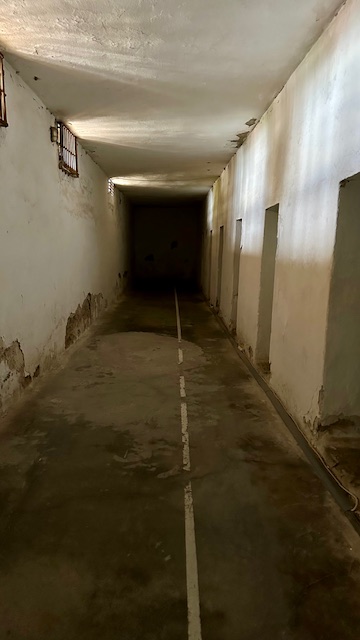




Walls of Thessaloniki – After exploring the Citadel (or Heptapyrgion) we walked along some sections of the Byzantine walls that were built in 315 BC. These 4 km long walls surrounded the city during the Middle Ages and until the late 19th century, when large parts of the walls, including the entire seaward section, were demolished as part of the Ottoman authorities’ restructuring of Thessaloniki’s urban fabric. In 1988, as part of the Paleochristian and Byzantine monuments of Thessaloniki, the walls were added to the UNESCO World Heritage Site because of their outstanding Byzantine architecture.

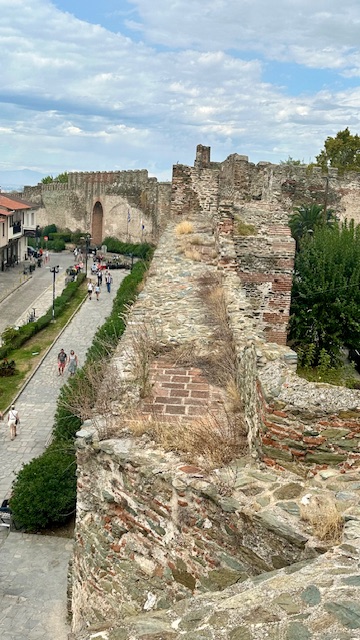
Trigonion Tower (or Alysos Tower) – The Trigonion Tower is the most famous and impressive tower of the Byzantine wall. It was built in the late 15th century to prevent an invasion of the city and help during a siege. From the top of the Tower, also called “the balcony of Thessaloniki”, you’ll have the chance to enjoy the magnificent and imposing panoramic view of the city hugging the sea.


The section of the walls near the Trigonion Tower looked nicely restored and the entry/exit Gate here too looked well maintained.

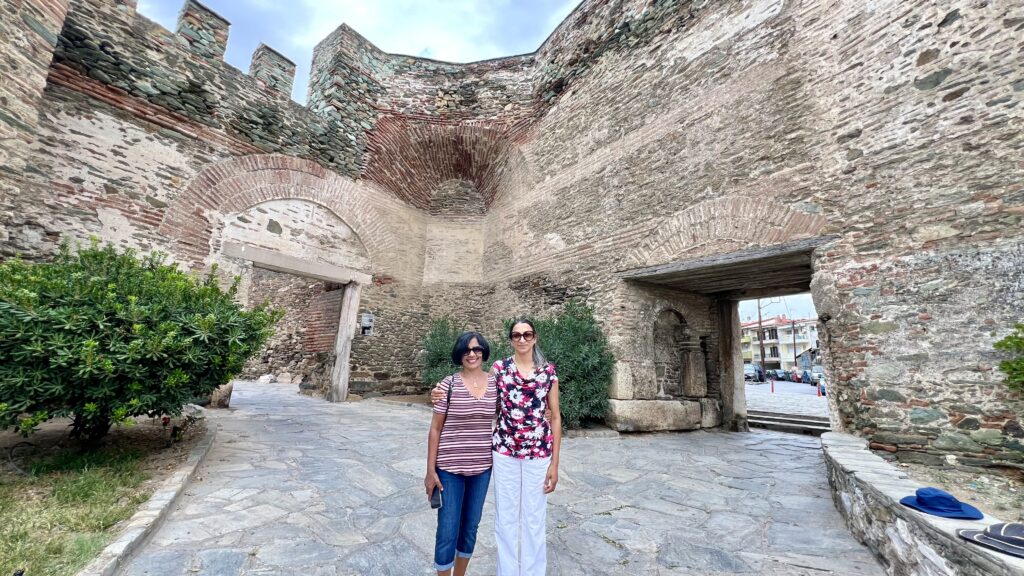
Church of St Paul – We got a great view of this church from the Trigonion Tower and decided to check it out on our way back to our hotel. The magnificent building is crowned by a flattened dome, a distinctive arch rises above the main building and decorates the central entrance. It is a new and modern church that was consecrated in honor of Apostle Paul in 1997.


Roman Forum (or Ancient Agora) – This was the heart of the ancient city of Thessaloniki. The Forum (Agora) was constructed by the Romans in the late 1st century A.D. Along with the Galerian Palace Complex it was the center of political and public life in Thessaloniki. It was a large open area surrounded by buildings of various functions some of which were elegant, impressive buildings, thus displaying the financial prosperity of the city, especially during the Hellenistic and Roman period. Being the social, religious and administrative center of the city, it was connected to all the main streets. It remained active during the 2nd, 3rd and 4th century AD. During this period the political centre of gravity gradually shifted towards the eastern part of the city along with the new Galerius Palace Complex.
The area of the forum was planned to be the site of the Thessaloniki Municipal Courthouse, but after the ruins were discovered by accident in 1960, the project was scrapped. Restoration efforts started in 1989 and the result of these efforts can be seen today in this beautiful, easily accessible archaeological site.



Church of Panagia Halkeon – is an 11th century church located south of the Ancient Agora near the center of the old city. It is another one of the 15 Paleochristian and Byzantine Monuments of Thessaloniki that were included in the UNESCO World Heritage List in 1988. The design of the church was inspired by the monuments of Constantinople, capital of the Byzantine Empire. In 1430, the Ottomans converted the church into a mosque, but in 1912, it was changed back to a Greek Orthodox Church. We visited the church after 12pm and hence was closed.


Church of Holy Apostles – This 14th-century Byzantine church is in the UNESCO World Heritage List because of its outstanding Byzantine mosaics and architecture. A characteristic feature of the Late Byzantine architecture is the main dome that rises above the barrel vaulting of the cross with the other domes over corners of the portico. During the Turkish period, the church was used as a mosque. The church was closed on the day we visited and hence could not see the frescoes and mosaics that were discovered during restoration work in 1940.



Walking around the city of Thessaloniki – All the places we visited on this page were within walking distance of our hotel. The only place we took a taxi, was to the Citadel in Upper Town to avoid the climb. Our walk back was all downhill.
Our hotel was close to the waterfront with many restaurants, bakeries, cafes, and ice cream shops. As you stroll around the waterfront you will come across the Aristotelous Square which is the main square in the city. The Square was designed by French architect Ernest Hebrard in 1918, but most of the square was built in the 1950s. Many buildings surrounding the central square have since been renovated and its northern parts were largely restored in the 2000s.



From Aristotelous Square, if you walk along Ernest Hébrard envisioned monumental axis you will reach Dikastirion Square and then the Roman Forum (see information above).


Church of Panagia Dexia – This church was within a few yards of the Triumphant Arch of Galerius. It is worth spending a few minutes checking out the inside of this church which was built in 1956.
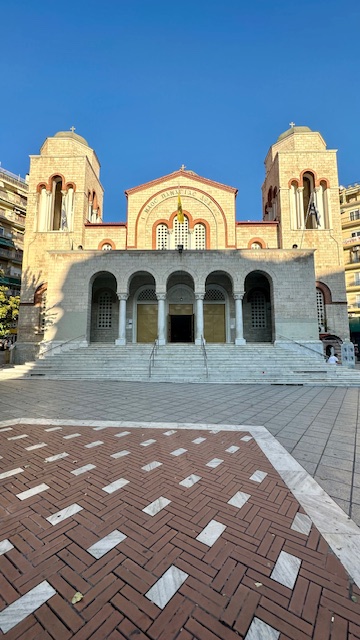



Monastery of St. Theodora – This monastery was next to our hotel and worth spending 15 min. It was named after Agia Theodora, who led a monastic life there in the 9th century. During the Ottoman occupation, it was one of the three monasteries that had not been converted into a mosque. It became a parish church in the 18th century and it has been operating as a male monastery for the last 40 years. The church of the monastery was rebuilt in 1935 in the place of the older main church, which was destroyed in the fires of 1890 and 1917.



Is Thessaloniki worth a trip? – If you have 2 days or more to spare, Thessaloniki is a great place to spend your time.
- Although it is the second largest city in Greece, it is cheaper, less touristy, and less crowded than Athens
- The old city has a long list of UNESCO World heritage sites all of which are walkable
- Perched on the edge of the Adriatic Sea, Thessaloniki is an ideal gateway to a Greek Island hopping trip. You can take a ferry from the port of Thessaloniki to the Sporades, Cyclades, etc.
- Mount Olympus is within driving distance from Thessaloniki